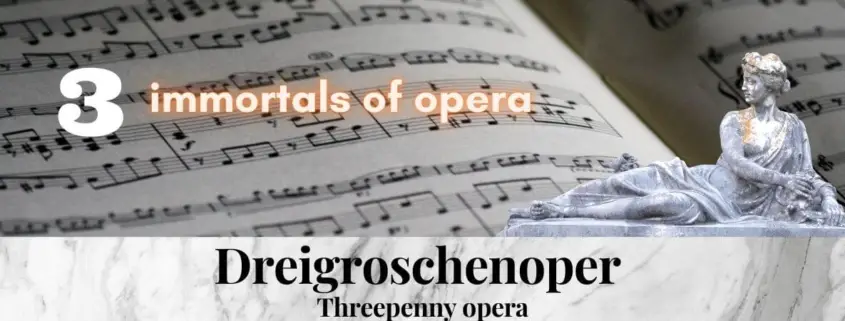The genesis of the Threepenny Opera was dramatic. Everyone expected it to fail. But the premiere on August 31, 1928 became a triumphant success never expected and made Kurt Weill and Bertold Brecht suddenly famous. Weill’s melodies became popular hits and the work was performed 10,000 times in the first 5 years alone.
The Famous Moritat of Mackie Messer
Moritaten (probably originating from the word “murder deed” or “morality”) were gruesome ballads sung at fairs and accompanied by violins or barrel organs.
From the beginning, the Moritat became a popular song par excellence and the most famous piece of the Threepenny Opera. Interestingly, this song was not included in the original version and the piece was written only at the last moment because the actor Harald Paulsen insisted on being the first to perform with a song.
The piece includes 6 verses and starts only accompanied by harmonium. With each verse more of the total 9 instruments of the band are added. Weill writes at the beginning “in the manner of a hurdy-gurdy”. The rhythm develops more and more into a foxtrot.
We hear the song in 2 versions. First the one of the first Macheath’, Harald Paulsen, to whom we owe the existence of the piece.
Der Haifisch, der hat Zähne – Paulsen.
Der Mond über Soho (The Moon Over Soho)
This number is a delightful caricature of conventional opera. While in Bellini’s Norma (and many other operas) we experience magical full moon nights, the moon over Soho is a grotesque grimace in the night sky.
Anstatt das …Das ist der Mond über Soho (No They Can’t Song)
The rousing cannon song
Briefly, a shudder seizes the wedding guests when Tiger-Brown appears, London’s dreaded police chief. He is an old childhood friend of Macheaths and has come only to congratulate him. Together, the two old war buddies sing a cannon song.
The so-called cannon song is a gripping ragtime with a rousing chorus, written in the tempo of the foxtrot.
We hear and see the duet in the 1931 film version.
John war darunter und Jim war dabei (CANON SONG).







Leave a Reply
Want to join the discussion?Feel free to contribute!